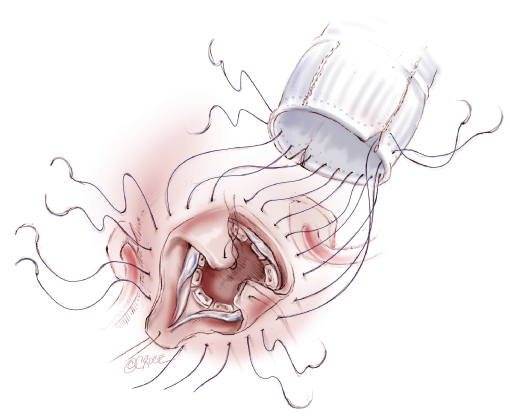Aortic Valve Repair
Background
The aortic valve is the exit point for blood being pumped to the rest of the body, regulating the single-directional flow of blood out of the heart. If the valve cannot open completely (aortic stenosis), the heart is forced to pump harder against the narrowed opening. Conversely, if the aortic valve does not close completely (aortic regurgitation or insufficiency), blood leaks back into the heart, similarly forcing the organ to work harder. The most common causes of aortic valve disease include congenital disorders, rheumatic valvular disease or calcification of adulthood. Patients can have an asymptomatic period before developing symptoms such as fainting, tiredness, shortness of breath and/or chest pains.
Definition
Aortic valve repair essentially involves repairing or modifying the components of the aortic valve without actually replacing it. This repair is particularly useful in cases of aortic regurgitation (AR), as one of the aims of aortic valve repair is to decrease the enlarged vessel to minimise blood leakage back into the heart. In “valve-sparing” surgery, the defect in the valve is directly repaired, while preserving the patient’s own native valvular structures. This option removes the need for life-long bloodthinning medications compared to valve replacement surgery.
Procedure
Aortic valve repair usually requires opening the chest to access the heart (sternotomy) and the use of a cardiopulmonary bypass machine, which acts as the heart and lungs for the patient’s body when the heart is stopped. The specific techniques of aortic valve repair surgery depend on the cause of the aortic regurgitation. The surgeon may perform valve-sparing surgery to reduce the diameter across the valve, or remove the entire valve and reimplant it inside an artificial graft with a smaller diameter. Other repairs include surgical manipulation of the geometry of the valves. If aortic regurgitation is caused by a tear in the valve, the surgeon may use a patch of the tissue from around the heart to repair the defect. A congenitally narrowed valve may be repaired by opening up the valves and realigning them appropriately.
Suitability
Aortic valve repair is mostly suitable for patients with aortic regurgitation (usually caused by expanded valve) rather than stenosis (narrowed valve), as this repair involves narrowing the area across the valve. Usually, patients considered for this surgery are young, wishing to avoid lifelong anticoagulation medications and expected to outlive the lifespan of a bio-prosthetic valve.
Benefits
There are several benefits of aortic valve repair surgery compared to aortic valve replacement. This includes:
- Lower risk of endocarditis (an infection of the heart)
- Reduced bleeding and clotting risk compared to mechanical valve implantation
- Reduced need for future reoperation compared to bioprosthetic valves
Risks
One of the risks associated with surgical valve repair is that the aortic regurgitation might reoccur. If this happens, a complicated reoperation may be required. Additionally, these operations are technically challenging, requiring longer time in the operating theatre and on the cardiopulmonary bypass machine. The decision for the specific type of surgery will involve weighing up the potential benefits against these risks. As for any kind of surgical intervention, the surgeon and patient should take into account what is most appropriate on an individual basis. For more information, please visit the following websites:
http://www.mayoclinic.com/health/aortic-valve-regurgitation/DS00419
http://my.clevelandclinic.org/heart/disorders/valve/aorticvalvesurgery.aspx

Services
Cardiac Surgery
- Aortic Arch Surgery
- Aortic Stenosis
- Aortic Surgery and Stroke
- Aortic Valve Repair
- Coronary Artery Bypass Grafting
- Heart Failure
- Tissue and Mechanical Heart Valves
- Type B Aortic Dissection
- Ventricular Assist Devices
- Hybrid Aortic Arch Surgery
- Marfan Syndrome
- Minimally Invasive Aortic Valve Replacement
- Minimally Invasive Atrial Fibrillation Surgery
- Minimally Invasive Mitral Valve Surgery 2015
